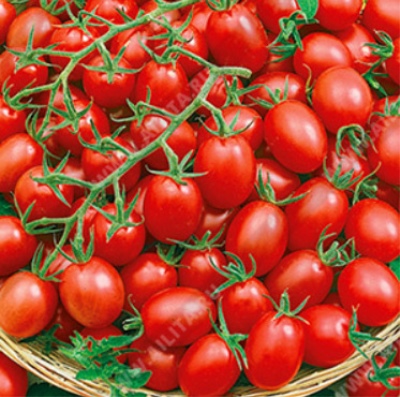
- Authors: Kachainik V.G., Gulkin M.N., Karmanova O.A., Matyunina S.V. (Agrofirma Aelita LLC)
- Year of approval: 2019
- Category: grade
- Growth type: determinant
- Appointment: fresh consumption, for whole fruit preservation
- Ripening period: early
- Ripening time, days: 100-105
- Growing conditions: for open ground, for film greenhouses, for growing on a windowsill, pot culture, decorative gardening
- Bush size: dwarf
- Bush height, cm: 50-60
The Button tomato variety was approved for use in 2019. It is determinant. The variety is suitable for growing in open ground, in greenhouses and hotbeds, and sometimes it is also grown at home in pots.
Description of the variety
This variety belongs to the dwarf species. The height of an adult bush reaches 50-60 centimeters. Plants have medium-length green leaflets.
The main qualities of the fruit
Unripe fruits are light green in color. Ripe vegetables are bright red in color. Tomatoes are relatively small in size, the weight of each vegetable is about 30-35 grams. Their shape is elliptical.
One cluster contains 14-16 fruits. Ripe tomatoes have a fleshy and soft pulp. Their skin is smooth, the inflorescence is complex, the stalk is articulated.
Taste characteristics
This tomato variety has a light sweet taste. It is perfect for fresh consumption, as well as for canning.
Ripening and fruiting
The Button variety belongs to the early varieties. Ripening occurs approximately 100-105 days after planting. At the same time, the crop can be harvested in July-August.
Yield
Button is a fruitful variety. Up to 3 kilograms of ripe vegetables can be harvested from one bush. From 1 square meter, you can get about 4.3-4.6 kilograms.
The timing of planting seedlings and planting in the ground
Sowing for seedlings is carried out from March 20 to April 10. Young vegetation is planted in open soil from May 15 to June 5.

Growing tomato seedlings is an extremely important process, because it largely depends on whether the gardener can harvest at all. All aspects must be taken into account, from seedbed preparation to planting in the ground.
Landing scheme
Such tomatoes are planted according to the scheme 50x40 centimeters. At the same time, the planting density is 4-5 plants per 1 square meter of territory.

Growing and caring
Seedlings are preliminarily prepared for growing in the open field. To do this, prepare seed material, small plastic containers, clean soil, which will need to be mixed in advance with nutritious biological dressings.
The earth, enriched with substances, is distributed over all containers. After that, the seeds are spread there. Sprinkle them a little on top. Remember to keep the soil slightly moist.
When the first 2 or 3 leaves appear, the seedlings are transplanted to a permanent place. Planting holes are pre-dug, top dressing is poured on their bottom.
Seedlings must be planted as carefully as possible with an earthen clod so as not to damage the root system of vegetation.After that, the soil is well watered.
In the process of their growth, the bushes will need to be formed. In addition, appropriate fertilization will need to be applied in a timely manner. It is worth using nitrogen fertilizing, they allow you to stimulate the growth of green mass. But it must be used in small quantities, because an excessive nitrogen content will lead to the fact that the plants will bear poor fruit.
You can also use micronutrient fertilizers - primarily magnesium and boron. The second is best used during the flowering period so that the flowers can set well.
It is also important to add organic compounds. Tinctures with poultry droppings, mullein, nettle can be optimal. They should only be used before fruit setting.
After tying, you can take homemade wood ash tinctures. Gardeners recommend applying fertilizers throughout the entire period of plant growth. Moreover, it is best to take both chemicals and folk remedies in order to achieve maximum results.
Also, the culture will need regular watering. In this case, it is necessary to ensure that the soil is not too waterlogged, otherwise it is possible to provoke the appearance of various harmful fungal organisms in the ground.




A plant needs different micronutrients at each stage of growth. All fertilizers can be divided into two groups: mineral and organic. Folk remedies are often used: iodine, yeast, bird droppings, eggshells.
It is important to observe the rate and period of feeding. This also applies to folk remedies and organic fertilizers.
Disease and pest resistance
The Button tomato variety boasts a fairly high resistance to diseases and pests. But it is still better to carry out preventive treatments with fungicides and folk remedies. They are most often done by spraying the aboveground part of the vegetation.
If you nevertheless saw various harmful insects (aphids, slugs) on the plants, then they will need to be manually removed. Immediately after this procedure, the culture is also carefully processed using ready-made chemical compositions, you can prepare a healing solution yourself using wood ash, onion husks, iodine.


Review overview
Many gardeners spoke positively about this tomato variety. Separately, it was said that it has good germination, resistance to various diseases and to cracking.
Also, users noted the excellent taste characteristics of these tomatoes, so they can be used in the preparation of a variety of dishes. According to gardeners, the Button variety is absolutely unpretentious; it can also be grown simply in pots on balconies.

























































































